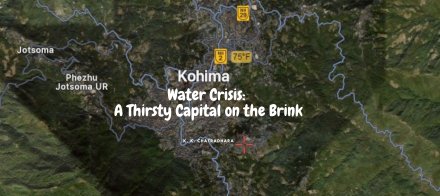Tripura’s floods ‘classic example’ of climate change intensifying extreme weather events: Experts
Deforestation, changing land use, encroachment of natural drainage, lack of flood infrastructure maintenance along with an undulating terrain mean floods are deadlier and harder to deal with
Experts have blamed human-induced climate change for the floods in Tripura that have claimed the lives of 31 people so far.
Tripura is prone to flooding due to its geographical location and topography. However, this time, the crisis that the heavy monsoon rainfall has unleashed is multifaceted. It led to overflowing rivers, landslides, and unprecedented flooding in dozens of villages.
The state also witnessed a record-breaking 288.8 mm of rainfall in a single day on August 20.
The heavy rainfall affected the districts of South Tripura, Khowai Tripura, West Tripura and Gomati. The South Tripura district is the worst-hit due to the floods.
According to the state’s Revenue Department, the most severely impacted areas are Bagafa (375.8 mm) and Belonia (324.4 mm) in South Tripura and Amarpur (307.1 mm) in the Gomati district.
Due to heavy rainfall, major rivers such as Howrah, Dhalai, Muhuri, Manu, and Khowai are known to have exceeded danger levels, heightening the risk of additional flooding in downstream areas.
For example, the Manu River in Kailashahar crossed the critical level of 23.05 metres at 8 AM on August 20.
Extent of damage
Landslides caused by rainfall have claimed seven lives, with two individuals still missing. Consequently, the death toll is likely to soar.
The floods also caused damage to livelihoods, with numerous people being forced to abandon their homes.
As many as 46,271 families have been displaced, with the total affected population being estimated at 1.7 million. Many displaced families were forced to take asylum in relief camps set up by the government and non-governmental organisations.
“We have not witnessed such a situation before. We have not only lost our houses but the cattle, which are our insurance against crop failures, are all gone,” Tokbulu Debbarma told Down To Earth (DTE). Tripura’s floods ‘classic example’ of climate change intensifying extreme weather events: Experts
Damned by floodwaters
Due to heavy rainfall, the Dumbur dam, located in the Gandatwisa sub-division and Dhalai district of Tripura, is overflowing and wreaking havoc in the areas nearby. Neighbouring Bangladesh, which is already embroiled in a political crisis, is also complaining about the release of water, which it claims has flooded many of its villages and the city of Feni.
Dumbur dam was built in 1974 and the increase in rainfall in recent decades has often overwhelmed its capacity.
This time, the authorities had no option but to release the excess water from the reservoir — after three decades. The last time water from the dam was released was in 1993.
Since the dam doesn’t produce any energy anymore, it is speculated that it has not been paid heed to or repaired for a long while.
The deputy general manager of the Gumti Hydel Project informed DTE that the release of water was imminent as the water level spiked up to 93.85 metres, whereas the danger level is 94 metres.
Tarit Kanti Chakma, the district magistrate of Gomati district has issued an advisory, urging downstream residents along the Gomati River to undertake appropriate precautionary measures.
But the rural residents in the downstream areas are virtually on their own.
“We had not witnessed such a flood ever. While we were responding to the crisis, the dam suddenly released excess water. Our house is located on an elevated hillock and we were assured of our safety. But as soon as the dam broke, water invaded our backyard and people ran all around in panic,” Sourav Debnath, a 30-year-old resident of a downstream hamlet, told DTE.
“And we just watched helplessly, thinking our house might be the next one. The water kept rising till 12 at midnight. I didn’t sleep for the entire night,” he added.
According to Debnath, it took 10 hours for the water to go down 18 inches. Presently, the water has almost entirely subsided.
“All we can see around the whole village are broken houses, ravaged forests, rubber plantations, mud-covered rice fields and people wandering, crying, looking for food and drinking water,” the 30-year-old said while sharing his ordeal.
Looking tense and worried, 55-year-old Shanti Jamatia of Killa village in Gumati district told DTE:
“Our pond and agricultural land got destroyed due to the heavy rainfall. Our rubber trees are damaged too. Who will compensate for our losses now?” she asked in vain.
Health concerns loom large
The floodwaters have also led to the contamination of drinking water sources, raising concerns about waterborne diseases such as cholera, dysentery, and typhoid.
The displacement of people also posed challenges in terms of hygiene and access to medical facilities. Antarlina Bhattacharjee, a 26-year-old, who was volunteered in the relief measures told DTE:
“When we went to the villages, people were competing for relief materials among each other and scuffles broke out. It was a desperate scenario. Our relief packages were not enough to placate them. And the worst is that they now have no clean water to drink, and many of them are already showing symptoms of water-borne disease. Because of the rise in water level, snakes are coming out and snakebites are yet another threat,” Bhattacharjee said.
Dissecting the disaster
The heavy rainfall and unprecedented floods that Tripura is experiencing is a stark reminder of the destructive impacts of climate change.
Tripura’s undulating terrain, with hills and valleys, uneven topography, and inadequacies in the state’s drainage system, makes it more vulnerable to flash floods and landslides.
The situation is barely better in the urban centres such as Agartala, which are reeling under waterlogging and difficulty in transportation.
The Northeastern state’s vulnerability is further aggravated by ongoing deforestation and shifts in land use patterns with new monoculture plantations like areca nut, which have intensified the severity of these hydrological challenges over time.
The reduction in forest cover has reduced the soil’s ability to absorb water, increasing surface runoff. Also, the steep slopes and deforested areas contribute to rapid runoff, exacerbating the flooding.
Changes to natural drainage channels for construction and agriculture further hampers water absorption and drainage, leading to extensive floods. The region experienced incessant rainfall during the monsoon season, which led to the swelling of rivers like Haora, Gomati, and Manu.
Poorly maintained embankments and the lack of proper flood management infrastructure make these rivers more likely to breach their banks, flooding nearby areas.
Lessons learnt?
Himanshu Thakkar, Coordinator, South Asia Network for Dams, Rivers and People (SANDRP), told DTE that such a heavy rainfall was bound to result in a havoc.
“So, the planning and actions to prevent the crisis from worsening should have been taken well in advance. They [authorities] could have started releasing water from Dumbur dam much earlier in lesser volumes rather than releasing it in one go,” he said.
“The release of water should have been done after alerting all the downstream areas. The Tripura Disaster Management Authority (TDMA) doesn’t have much information on their website and the Facebook page,” Thakkar pointed out.
Regarding the impact of climate change on Tripura, Thakkar underlined India’s disaster management system at large needs an overhaul.
“So there was heavy rainfall upstream, which they did not care about and that created havoc. They are not updating their communication systems in a timely manner,” he remarked.
“For example, the same was the case in Sardar Sarovar Dam (Gujarat) during last year’s heavy rainfall. They didn’t open the gates till water entered into the reservoir,” he reminded.
(by Thomas Malsom and Monoj Gogoi)
https://www.downtoearth.org.in/natural-disasters/tripuras-floods-classic-example-of-climate-change-intensifying-extreme-weather-events-experts


